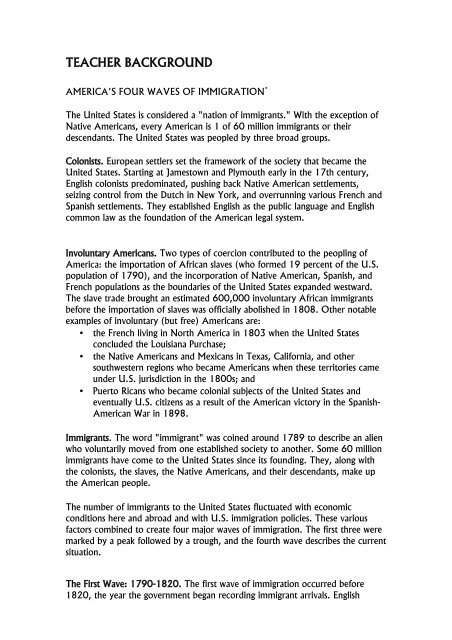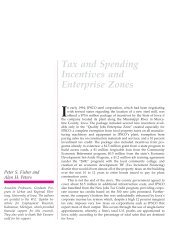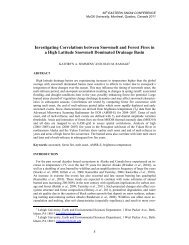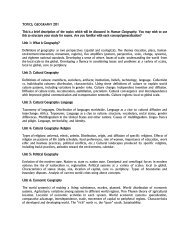PEOPLE ON THE MOVE - Department of Geography
PEOPLE ON THE MOVE - Department of Geography
PEOPLE ON THE MOVE - Department of Geography
You also want an ePaper? Increase the reach of your titles
YUMPU automatically turns print PDFs into web optimized ePapers that Google loves.
TEACHER BACKGROUND<br />
AMERICA'S FOUR WAVES OF IMMIGRATI<strong>ON</strong> *<br />
The United States is considered a "nation <strong>of</strong> immigrants." With the exception <strong>of</strong><br />
Native Americans, every American is 1 <strong>of</strong> 60 million immigrants or their<br />
descendants. The United States was peopled by three broad groups.<br />
Colonists. European settlers set the framework <strong>of</strong> the society that became the<br />
United States. Starting at Jamestown and Plymouth early in the 17th century,<br />
English colonists predominated, pushing back Native American settlements,<br />
seizing control from the Dutch in New York, and overrunning various French and<br />
Spanish settlements. They established English as the public language and English<br />
common law as the foundation <strong>of</strong> the American legal system.<br />
Involuntary Americans. Two types <strong>of</strong> coercion contributed to the peopling <strong>of</strong><br />
America: the importation <strong>of</strong> African slaves (who formed 19 percent <strong>of</strong> the U.S.<br />
population <strong>of</strong> 1790), and the incorporation <strong>of</strong> Native American, Spanish, and<br />
French populations as the boundaries <strong>of</strong> the United States expanded westward.<br />
The slave trade brought an estimated 600,000 involuntary African immigrants<br />
before the importation <strong>of</strong> slaves was <strong>of</strong>ficially abolished in 1808. Other notable<br />
examples <strong>of</strong> involuntary (but free) Americans are:<br />
• the French living in North America in 1803 when the United States<br />
concluded the Louisiana Purchase;<br />
• the Native Americans and Mexicans in Texas, California, and other<br />
southwestern regions who became Americans when these territories came<br />
under U.S. jurisdiction in the 1800s; and<br />
• Puerto Ricans who became colonial subjects <strong>of</strong> the United States and<br />
eventually U.S. citizens as a result <strong>of</strong> the American victory in the Spanish-<br />
American War in 1898.<br />
Immigrants. The word "immigrant" was coined around 1789 to describe an alien<br />
who voluntarily moved from one established society to another. Some 60 million<br />
immigrants have come to the United States since its founding. They, along with<br />
the colonists, the slaves, the Native Americans, and their descendants, make up<br />
the American people.<br />
The number <strong>of</strong> immigrants to the United States fluctuated with economic<br />
conditions here and abroad and with U.S. immigration policies. These various<br />
factors combined to create four major waves <strong>of</strong> immigration. The first three were<br />
marked by a peak followed by a trough, and the fourth wave describes the current<br />
situation.<br />
The First Wave: 1790-1820. The first wave <strong>of</strong> immigration occurred before<br />
1820, the year the government began recording immigrant arrivals. English
















